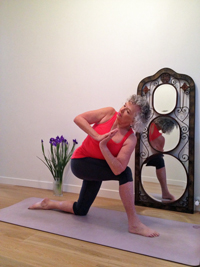 Breathing into a twist helps us mindfully move deeper without wrenching our body. Demonstrated by YLB Reader Kay Gries
Breathing into a twist helps us mindfully move deeper without wrenching our body. Demonstrated by YLB Reader Kay Griesby Kara-Leah Grant
There’s loads of phrases which yoga teachers toss around willy nilly that after time cease to have any real meaning.
Phrases like:
- Surrender into the pose
- Let your heart open
- Find your centre
- Honour yourself
- Let yourself come into a place of…
- Honour yourself for committing to your practice today…
I know, I say these things. Thing is, many of these phrases have value and depth, and – in the right circumstances – apply to the practice.
In particular, the much over-used “breathe into it” is gold – when you know what it means and how to apply it.
The problem is, many people in a yoga class have no idea how to breath into anything other than their lungs, and many even struggle with that.
So what does “breathe into it mean”?
First, a detour.
Yoga as a practice is best taught one on one with a teacher who can respond to the actual needs of the student as they arise. That means that if and when the phrase “breathe into it” was used, the student would both need to hear that particular phrase and be ready to grasp and apply what it means.
However, 99% of us learn yoga in class situations, where the teacher is speaking to anywhere from 5 students to 100 students all at different places and stages in their understanding of yoga. The phrase “breathe into it” might be perfect for one student in the room at one time, and completely useless for all the rest.
Until the day when it does become useful and you suddenly get it and realise, oh… that’s what that teacher’s been going on about for all this time.
That’s it indeed.
So if you don’t know how to breathe into it in your yoga, don’t worry about it. It doesn’t matter. With practice, attention and intention, one day, you will know.
That said, it doesn’t hurt to also apply yourself and read and practice at home, playing with the concept of breathing into all by yourself. That’s a great way to learn yoga.
Now.
When I practice yoga, I breathe into it all the time. In fact, breathing into my body is how I practice.
It is first and foremost the only action that initiates and drives everything else. From a place of stillness, I breathe. That breath travels – or experientially appears to travel – all around my body. That breath then moves my body according to what asana I’m currently practicing or about to practice.
In Tadasana Pose, or Mountain Pose, this means that from a standing tall position, I breathe down into my lungs, allowing my rib cage to expand and drop. The breath travels down my spine into my pelvis and lengthens my tailbone to the ground. As I inhale, the breath travel back up my spine and lengths the crown of my head toward to sky.
On the next exhale, I again feel the breath dropping down through the body, down the back of the body and into the heels and my feet release into the earth – in essence, grounding. The inhale again rises up the body and my sternum may lift and my collarbones broaden.
Every inhale expands and opens my body according to where I’m holding tension and what the potential of the posture is.
Every exhale grounds and deepens the posture, according to where what parts of the body are touching the ground and where I need to soften.
This is what breathing into it means – it’s an organic and internal process that allows the yoga posture to open up from within.
Every movement, every posture, all the time. That’s yoga.
Now, you’re just beginning yoga, you’ve got no idea how to breath into your spine, let alone your feet. How on earth to you get from where you are now to where I am now?
Practice. Intention. Imagination. Openness. Willingness.
That’s how.
The first step in learning how to let your breath led your yoga is to simply be aware of your breath as it is, in every moment.
At this stage, you’re not trying to change anything, fix anything, or direct anything. You’re just noticing what is. You’ll notice where you hold your breath and where you take short sharp breaths and where your breath gets stuck. That’s your breath talking to you and giving you feedback about how you’re experiencing the posture. Notice it. Learn to repsond to it.
Case in point.
I’m at Bikram. we’re going into a standing background. The woman beside me is taking short gasping breaths, as if she’s a goldfish been tossed from her bowl. Her breath is telling her all kinds of things right now – but unless she knows to listen to it, she likely hasn’t even noticed what’s going on.
She’s got no idea what her breath is telling her, and I know that, because she’s not responding to the messages.
So before you even think about breathing into anything, you need to learn to listen full-stop.
Which brings me back to my initial point about over-used phrases in yoga classes. They sound empty and meaningless much of the time – because they are unless they are specifically directed at a student who needs to hear that actual phrase in that precise moment. Otherwise, they’re just catch-all sound-good yoga-speak.
But when they are directed at a student – especially one who hears the phrase and is able to respond to it – the energy in the room knows. There’s a collective noticing of the specific directive and the specific response.
So next time you hear a phrase in class and it you have no idea what it means, take the time to go and ask the teacher afterwards. If they’re a decent yoga teacher, they’ll be able to tell you what it means and how it applies to your practice. If they’re really good, they may even be able to demonstrate what it means.
If you came up to me at the end of class and asked me what it means to breathe into it, here’s what I’d say to you. Or rather, what I’d get you to experience.
Camel posture is one of my most favourite postures for demonstrating the need to breathe into anything. So often people assume the starting position and then physically crank themselves back into the backbend and THEN attempt to breathe.
Instead, my suggestion is to assume a starting position – kneeling straight up with the hands on the hips, fingers facing up.
Next comes the breath- before moving, before bending back, before going anywhere. This is where we get to practice breathing into it.
As you exhale extend your tailbone toward the ground creating space in your lower spine and squeeze your inner thighs together.
As you inhale press your hips forward and allow the breath to rise up the front of the body lifting the sternum toward the sky.
At this point, the head may or may not begin to look up and back.
Repeat – exhale and find stability, strength and grounding. Inhale and find expansion, lift and opening.
Oscillating between the inhale and exhale like this – rooting and growing – you’ll find that Camel naturally opens up. You don’t have to move your body anywhere – you are moved into it. Best of all, you are moved into it with a full, natural, expansive breath.
That’s breathing into it.
But wait, there is another way to see breathing into it.
So often we physically move ourselves into postures and push further than we’re ready to go, tensing up the very area we’re meant to be releasing. Then we find ourselves resisting the posture.
It’s at this point our teacher will often tell us to “breathe into it”. The reason?
When we breathe deeply and with attention to both our breath and the area we’re fighting against, that holding, resistance or tension will begin to soften and let go.
So we notice where we’re holding tension in a posture. We bring attention to our breath. We allow our breath to be soft and full, maintaining that dual attention on breathing and the place of tension. That wilful connection of the two concepts in our mind is enough. Breath enters the area of tension. Tension melts.
So next time you’re in a yoga class and the teacher says either to the class or to you in particular, breathe into it, here’s how to respond.
Check and see it applies to you – start by listening to your breath. Is it soft and full? If it’s tight, or you’re holding the breath, back out of the posture until you reach a place where you can breath comfortably and then allow the breath to take you back into the posture.
Check in on your body – are you subconsciously resisting the posture in any way? Can you sense any tension in your body? Keep your attention on that place in the body and bring full attention to your breath as well. Focus on letting go on the exhale, softening and releasing as much as you can. Keep that dual awareness going.
Finally, maintain that awareness on your breath and surrender to it’s directive – let your breath take you into the postures, oscillating inhale and exhale by oscillating inhale and exhale. Just like I do in this short video of Standing Wide-Legged Forward Bend.
Here, I use my breath to open the posture up from the inside. That’s breathing into it. I breathe into my spine, I breathe into my hips, I breathe into my upper back… I let my breath take me deeper into the posture and release any areas of tension.
And that’s it. Now you know what it means to “breathe into it”. Now you can make it work for you.
Before you go though, a 2 minute video of me demonstrating one way to breathe into a posture.
Kara-Leah Breathing into Wide-Legged Forward Bend
Heard a yoga phrase that needs explaining? Drop me a line and I may just write an article about it.

spot on as usual K-L – good stuff! Michelle x
Kia ora K-L
I just listened to your interview with Mark W. fantastic… bloody good stuff… and yes you were the right one to interview him, like he said you are there.. thankyou. now I will go on amazon and try to get his new book . Terimoana
What a brilliant article and vid…I often find class way too fast for this exploration!
Glad you enjoyed it Gisele.. and great feedback too! That’s the beauty of home practice, we can take all the time we like to explore.
This was so extremely helpful, thanks! I have been struggling with the ‘breathe into’-concept. My frustration peaked a couple of days ago when I heard someone say “breathe into your eyeballs”. Really? Guess this one can be filed under the yoga mumbo-jumbo.
As for what you are explaining: I get that. Finally someone who can make me see the light. Thanks!